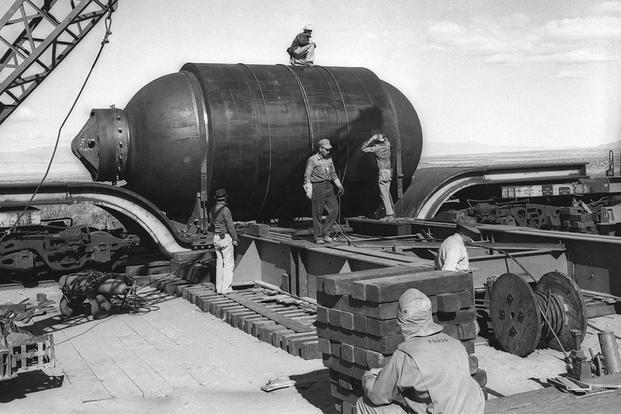The atomic age formally began at exactly 5:30 a.m. (Mountain time) on July 16, 1945.
At that moment, the Manhattan Project staff succeeded in creating an atomic bomb. Known as Trinity, the explosion yielded 18.6 kilotons of power, which was smaller than the bombs that would later destroy Hiroshima and Nagasaki and hundreds of times weaker than the warheads that would maintain the nuclear balance throughout the Cold War.
While this explosion marked success in the quest for atomic power, it did not denote its beginning.
While academics suggest that the search for atomic power is as old as scientific inquiry and may have alchemic heritage, most agree that atomic science began in earnest near the turn of the century in England.
In 1919, Ernest Rutherford successfully transmutated one element when he changed several nitrogen atoms into oxygen at Cambridge University. At the time, scientists conceptualized the atom as a miniature solar system. Rutherford's work yielded the basic science necessary for understanding the mechanics of the atom and helped identify the high-energy proton particle as well as the electron.
James Chadwick would add to this knowledge, by identifying the third neutral particle that makes up the atom, the neutron. While naïve by today's standards, this work set the stage for 20 years of vigorous scientific exploration into the fundamental building block of matter.
Once the blocks have been identified, the natural desire to take things apart and reassemble them took over. In 1934, Enrico Fermi led the charge going against the initial beliefs of Rutherford, Niels Bohr and Albert Einstein. He and his colleagues bombarded 63 elements with atomic particles and created 37 new radioactive elements.
While Fermi had "discovered" fission, two scientists in Nazi Germany first understood the process as fission in 1938. That year near Christmas, Otto Hahn and Fritz Strassmann found that the nuclei of most elements changed during neutron bombardment. Identifying the results as unique elements from the original substance, the two Germans are credited with the discovery of the fission process.
During this work, the horrors of pre-World War II Europe were underway. A mass exodus of scientific expertise was occurring as Jewish and sympathetic scientists escaped Nazi persecution.
Less than a year after the Hahn-Strassmann work, Alexander Sachs, a Wall Street economist and unofficial adviser to President Franklin Roosevelt, delivered a letter that would change the course of atomic science in the United States. The letter, written by Einstein at the request of Leo Szilard, spoke of German work with uranium that could result in "extremely powerful bombs." The letter urged Roosevelt to begin a government-sponsored project.
The president answered Einstein's letter on Oct. 19, 1939, announcing that he had set up a committee to study uranium. This committee was the first government step toward the Manhattan Project.
In its first report on Nov. 1, 1939, the committee recommended that the government sponsor further work on Fermi and Szilard's chain reactions. This recommendation resulted to the first government outlay of funds -- $6,000 in February 1940. The uranium committee continued to synthesize the scientific work on the atom and sponsored research. Under the direction of the National Defense Research Committee, the group pushed toward producing practical means of fission and identifying the means of making the construction of a nuclear "assembly line."
Though work to create fission of any explosive power was discouraging in 1940 and for most of 1941, the National Defense Research Committee received a draft report from London that a "critical mass" of only 10 kilograms of uranium would be large enough to produce an enormous explosion. The report suggested that a bomb this size could be ready in two years and be delivered by an aircraft.
Roosevelt authorized U.S. Army involvement in the project on Oct. 9, 1941, and the Army began attending meetings in March 1942. Planning for an American bomb formally began in May 1942, when Vannevar Bush instructed Arthur Compton to meet with the S-1 (codename of the uranium research project) section leaders to make recommendations on all approaches to the bomb.
The project was reorganized under the Army's direction in September 1942. On Sept. 17, 1942, the Army appointed Col. Leslie Groves to head the Manhattan Project. The Army and the demands of war made Groves' mission clear -- build a useful bomb in as little time as possible.
That fall, the work of a young theoretical physicist and his group of "luminaries" came to the attention of the Manhattan Project leaders. Robert Oppenheimer and his team (Felix Bloch, Hans Bethe, Edward Teller and Robert Serber) had estimated that the critical mass was nearly twice what was estimated six months earlier, but his group also began to theorize about the use of fusion to power the bombs.
Work continued both on the general feasibility of building a bomb and on the method of making its production practical for several months. On Dec. 2, 1942, Fermi's team conducted the first sustained chain reaction. Compton relayed reports of Fermi's success reached the S-1 executive committee stating, "the Italian navigator has just landed in the new world. … Everyone landed safe and happy."
With this news and recommendation that suggested a bomb could be achieved as early as 1944, Roosevelt made his decision. On Dec. 28, 1942, he authorized the Manhattan Project to build a full-scale plant to produce enough fissile material to produce the bomb.
Before delivering Trinity on July 16, 1945, the Manhattan Project's cost would rise to more than $2 billion. With each incremental step, the movement toward the bomb made way and gained momentum.
Want to Know More About the Military?
Be sure to get the latest news about the U.S. military, as well as critical info about how to join and all the benefits of service. Subscribe to Military.com and receive customized updates delivered straight to your inbox.















